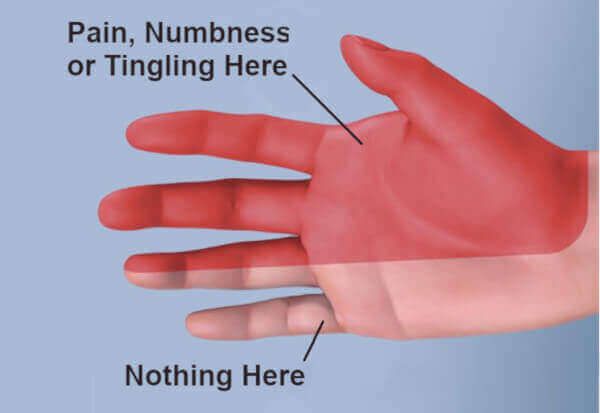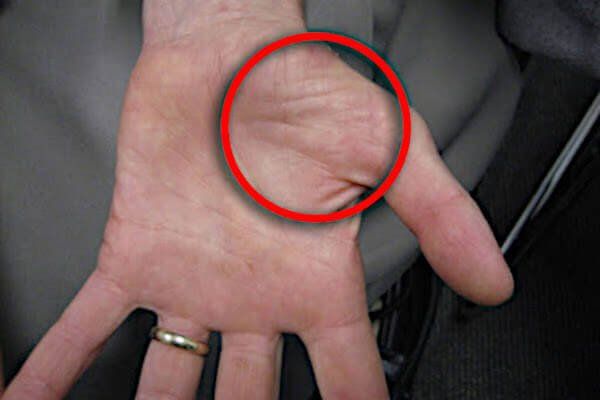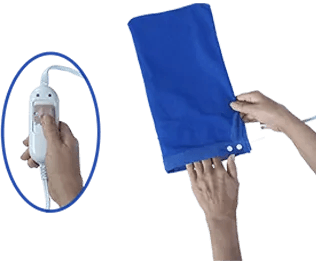Carpal Tunnel in Hands & Fingers
Having carpal tunnel in hands and fingers means feeling one or more of these symptoms: pain, numbness, tingling, burning, shooting electric shocks, weakness, and clumsiness. This is a neurological disorder
that doesn't usually get better by itself. And it affects over 5 million Americans.
Other
symptoms of carpal tunnel syndrome can be "somewhat" tolerable. But the numbness, tingling or pain in your palm and fingers will interrupt every aspect of your life. Many patients describe it by saying, "I feel like cutting my hand off."
The frustration of having these symptoms
constantly
is bad enough. But add to that another problem: using a treatment that doesn't seem to work. That's especially infuriating when your
doctor recommended that treatment, and symptoms are the same or even worse.
What most people don't realize is that carpal tunnel syndrome CAN be treated successfully without hand surgery. But you MUST use the proper treatment(s) on a regular basis for at least 4 weeks.
There's no magic bullet, just smart therapy.
There are 4 carpal tunnel treatments which, when used in combination, will eliminate symptoms for good. Here's how to do them.
Seeing a doctor
By far,
most people treat carpal tunnel syndrome themselves, without ever seeing a
doctor. And if they see a doctor, here's what's usually prescribed:
- The doctor recommends
hand rest and
night bracing.
- If symptoms don't subside, the doctor recommends
steroid shots
or
carpal tunnel surgery.
The above recommendations are a great plan. And when properly performed, they usually work. But many patients never get good results.
Why?
Because they either:
- Didn't brace their hand properly or
- Were not informed of more aggressive therapies to use in combination
Success rate of surgery
The success rate of
carpal tunnel surgery
depends primarily on how severe your symptoms are at the time of surgery.
If you let carpal tunnel syndrome run it's course without treatment (or having failed multiple treatments) it will advance to the
severe stage. This is when symptoms are maximally excruciating.
And if patients wait too long after that, they will ultimately reach the
end stage of carpal tunnel syndrome (see box below).
Avoid end stage at all costs!
Don't let "end stage" happen!
Non-surgical carpal tunnel treatments
There are 4 main non-surgical treatments for carpal tunnel syndrome. Nonsurgical treatments, when performed alone, are
at least as effective as surgery.
conservative
But when combined, these treatments provide far better results than surgery, and often at a fraction of the cost. They also work for even severe symptoms:
- Myofascial massage
- Nocturnal heating
- Night bracing
- Stretching exercises
It's usually best to 2 or more of these techniques simultaneously. And as a general rule, and except for the steroid injection, they should be used daily for about 4 weeks. More often is required for more severe symptoms. Each technique is outlined below.
Myofascial massage
Myofascial massage (or more properly,
myofascial release massage) is a technique used by therapists and chiropractors to treat carpal tunnel syndrome. It's actually an ancient technique applied to this
disorder of modern society.
Myofascial release massage aims to loosen and break adhesions which form between tendons. The adhesions cause inflammation and swelling, which exert pressure on your median nerve. And this nerve pressure is why you get symptoms of carpal tunnel syndrome.
When the adhesions are broken and dispersed by massage, tendon swelling lessens. The result is that symptoms disappear.
For moderate to severe cases of carpal tunnel syndrome, twice daily massage for at least 4 weeks is required. When myofascial massage is performed by a therapist, patients see
80% to
90% effectiveness. When myofascial massage is performed by the
CarpalRx (an automated myofascial release massager) patients see
97% effectiveness.
Night bracing
We all bend our hands backward (wrist is in extension) when we sleep. It's natural and unconscious. But that's very bad for your wrist joint if you have carpal tunnel syndrome. The backward bending further crushes the median nerve, making your symptoms worse.
A wrist will maintain your hand in a "neutral" (or straight) position so you wrist can rest. It also avoids backward bending without harming your wrist joint.
However, don't use just
any
wrist brace from your pharmacy. Chances are it's NOT a
certified
carpal tunnel night brace. If it has a
palmar spine
then it's not appropriate for your condition. In fact, it will
worsen
your symptoms.
Only use a
certified carpal tunnel night brace to keep your hand in a neutral position as you sleep.
Stretching exercises
Symptoms of carpal tunnel in hands and fingers are the result of
flexor tendon swelling
inside the wrist joint. This causes restrictions which inhibits tendons from gliding smoothly.
But
carpal tunnel stretching exercises help lubricate the tendons. That enables them to glide without restrictions. By doing so, the swelling decreases and fluid pressure is relieved inside the wrist joint.
The importance of night time heating
Fundamentally, carpal tunnel syndrome is an injury to the median nerve (by swollen tendons). And
applying heat to injured tissues speeds healing. This is why heat actually accelerates the healing process inside the wrist joint and restores your hand.
Applying heat (as from a heating pad) immediately after CarpalRx therapy amplifies the effects of the myofascial release massage. As the CarpalRx breaks up adhesions and drains fluid, the heat and exercises eventually restore damaged tissues.
Their combined effect is much greater than one treatment alone.
Summary of a lesson learned
Gavin found the CarpalRx just in time. Without it, I believe in another few months his hand would have been irreversibly damaged by carpal tunnel syndrome. Then nothing could have helped him.
Gavin learned 3 lessons that everyone who has symptoms of carpal tunnel in hands and fingers should know. They are:
- Surgery isn't the answer.
Carpal tunnel surgery is only
50% effective, even under the best circumstances. It certainly will not work with severe or end stage carpal tunnel symptoms.
- Doctors make mistakes too. Doctors are people, and they're just as fallible as anybody else. If you get
bad advice it's usually not intentional. So be your own healthcare advocate. That means
always
get a second opinion. And learn as much as you can about carpal tunnel syndrome.








